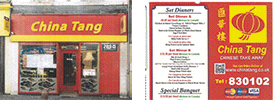Take-homes for takeaways - conduct trade mark searches before using a new mark
The owners of the Cantonese restaurant called “China Tang” at London’s Dorchester Hotel own a 2005 UK registration for restaurant services for the series mark below:

The defendant runs a Chinese takeaway in Barrow-in-Furness, which started using the name “China Tang” in 2009. Images of the shop front and menu are below:

The claimants alleged trade mark infringement under Section 10(2) and (3) Trade Marks Act 1994; and also passing off. The defendant asserted honest concurrent use as a defence to infringement.
The 10(3) claim failed because the claimant did not enjoy sufficient reputation in its mark by the time the defendant started operating. The passing off claim also failed because there was no evidence of any deception or even doubt about a connection between the two businesses in the minds of the relevant public, notwithstanding their simultaneous trading for 12 years. If any consumers had become aware of the two businesses, there was no reason to suppose that this has led to a belief that there was a connection between them.
The defendant’s takeaway services were held to be closely similar to the “restaurant services” covered by the registration. The marks were identical aurally and visually similar.
The defendant relied on the fact that despite 12 years of co-existence, there had been no instances of confusion.
Absence of confusion
Although Stichting BDO v BDO Unibank Inc [2013] EWHC 418 (Ch) (at para 167) had noted that the absence of confusion is not fatal to an infringement claim, the longer the period of co-existence without such evidence emerging, the more significant it is. In the BDO case that period was over eight years, which the judge felt was an important factor. However, Compass Publishing BV v Compass Logistics Ltd [2004] EWHC 520 (Ch) noted (at paras 22 and 23), that the law of infringement is not simply reflective of the marketplace.
The question of infringement must assess the likelihood of confusion were the claimant to use its mark in a normal way as regards all services covered by the registration (including the same specialist field in which the defendant operates).
The defendants’ point that a modest takeaway had little in common with the claimants’ opulent restaurant largely faded away if the relevant comparison includes the earlier mark’s use as the trading name of a low price restaurant, as would be the case following Compass.
The lack of confusion over 12 years was likely due to the differences in location and style between the two businesses. The judge also felt it likely that the reputation of the claimants’ restaurant, though certainly extending beyond Park Lane, had not extended to those who knew of the takeaway (and vice versa). However, this did not mean no likelihood of confusion according to a correct application of section 10(2). Because of the similarity of the marks and the relevant services, a likelihood of confusion was held to exist.
The principles relating to the defence of honest concurrent use were summarised in Victoria Plum Ltd v Victorian Plumbing Ltd [2016] EWHC 2911 (Ch) (at para 74). In short, where two entities have co-existed for a long period, honestly using a similar name, the inevitable confusion that arises may have to be tolerated where the name indicates the goods/services of either entity as opposed to one alone. However, the defendant must not take steps which exacerbate the level of confusion beyond that which is inevitable, and to encroach upon the claimant’s goodwill.
The defendant admitted that he had not undertaken any searches for “China Tang”. Falling back on first principles, it seemed to the judge that had the defendant been a large enterprise (with an in-house trade mark department) which diversified by opening a single takeaway and failed to conduct searches, it would be hard not to conclude absent good reasons that this failure was not in accordance with honest practices. Setting up even small businesses likely requires competent legal advice on a variety of matters including trading names. A public register of other parties’ rights is there to be consulted, in part so that those rights may be respected. In the modern climate of easy trade mark/internet searches, if a party starts to use a trading name without appropriate advice and simple searches, such use will not have been honest concurrent use without some reason why it should be considered such. There was no such reason in the present case.
Take-home messages
It’s unclear why the claimant did not have a plain word mark registration for its brand – this should be the first thing a new business considers. The case also highlights the value of (and in many cases the need for) conducting searches before seeking to register or use a new mark.
Case details at a glance
Jurisdiction: England & Wales
Decision level: IPEC
Parties: Gnat & Company Limited and China Tang London Limited (claimants) v West Lake East Limited and Honglu Gu
Date: 16 February 2022
Citation: [2022] EWHC 319 (IPEC)

